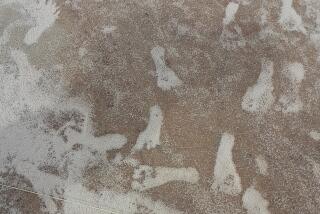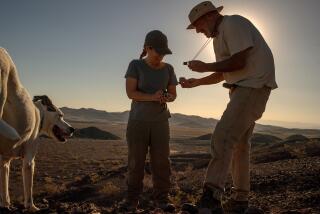Archeological Dig--Just Rocks or Ancient Tools?
YERMO, Calif. — Once a month, small groups of men and women gather near this small Mojave Desert town to carry on the meticulous, methodical tasks of an archeological dig begun more than 25 years ago by famed fossil-finder Louis Leakey.
Working out of deep, vertical pits on the slopes of a mountain and using dental picks, ball peen hammers, tiny brushes and trowels, the excavators have dug up literally tons of small rocks. In the process, they have become part of a scientific dispute.
A few scientists believe the rocks are prehistoric tools manufactured 200,000 years ago, which would make them the earliest indication of man’s presence in the Western Hemisphere.
But other scientists scoff at that theory, saying the unusual shaping of the rocks is the result of natural causes.
Still others are willing to concede that the rocks are man-made tools, but nowhere near the age claimed.
Most anthropologists believe that the first humans migrated to North America 10,000 to 12,000 years ago.
Other than the rocks with sharp edges, no other evidence of early man’s presence has been unearthed at the site--no skeletal remains, no projectile points, no tool handles.
The five-acre dig area has been named the Calico Early Man Archeological Site and is on the National Register of Historical Places. It is 140 miles northeast of Los Angeles in the arid desert north of Interstate 15 and is on land administered by the U.S. Bureau of Land Management.
About 60,000 small rocks, each believed by archeologist Ruth DeEtte (Dee) Simpson, 71, to show some evidence that man shaped them, are stored in hundreds of boxes in the basement of the San Bernardino County Museum in Redlands.
Each box is labeled as to the type of tool. There are scrapers, boring tools, picks, axes, anvils, hammer stones, cutting implements; 60 different types in all.
“We have about 1,000 really good pieces, tools of mint quality,” Simpson, the project director, said as she placed several of the best examples on a table in the basement storage area and laboratory.
Every Tuesday for almost as many years as the dig has been going on, a dozen volunteers spend eight hours sorting, classifying and analyzing rocks recently unearthed from the pits.
Simpson, curator of archeology at the San Bernardino County Museum from 1964 to 1982 who now is curator emeritus, has been involved in the Calico Early Man dig since its inception.
While working at Los Angeles’ Southwest Museum in 1952, she did a survey at the site that yielded samples of what appeared to be rock tools. She showed the rocks to archeologist Leakey, noted for his discoveries of the bones of early man in Olduvai Gorge, East Africa.
Leakey came to Southern California and launched the dig at the site on Nov. 1, 1964. He received National Geographic Society grants totaling $49,000 for the first four years of the dig. Several other grants were obtained and the meticulous, inch-by-inch digging with tiny tools continued on a daily basis for eight years.
Leakey served as project director and the excavation site was originally called Camp Leakey. He visited the site two or three times a year, staying at the most two or three days each time. When he died in 1972, Simpson became project director.
There currently are three master pits and 24 smaller pits and trenches. The rocks resembling tools have been found in six of the pits.
Since 1972, the digging has been conducted by supervised volunteers, many from university archeology classes or members of the Friends of Calico Early Man Site support group. A regularly scheduled dig takes place the first weekend of each month, with other work being done from time to time by various groups.
The BLM underwrites the excavation and visitors center at the site with a $12,000 annual grant. The BLM also provides fresh water and security, and keeps the road open to the excavation area.
Yvonne Lipking, 57, is the only paid employee of the archeological endeavor. For 10 years she has run the visitors center. She conducts 6,000 to 8,000 visitors a year on tours Wednesdays through Sundays.
Geologists James Bischoff of the U.S. Geological Survey, Richard Ku of USC and Roy Shlemon, who owns a geology business, came up with the 200,000-year-old date for the rocks in 1980. They based their finding on the results of a uranium-thorium dating process.
Simpson theorizes that the site served as a stone-tool workshop, quarry and camp for early man. “Some of the tools made of chalcedony, chert, jasper and siliceous limestone resemble similar tools found in China, Korea and Siberia,” she said.
She added, “Obviously, what we would like to happen is have the tools receive universal acceptance by scientists, find supportive evidence and nail down the dating.”
H. Marie Wormington, curator emeritus of archeology for the Denver Museum of Natural History, is among those who dispute the age claimed for the rocks.
“It is still very controversial. I believe they have found some man-made tools, but not of any great age. There is no good supporting stratigraphic evidence to suggest the tools are as old as they claim,” Wormington said.
Archeologists generally have designated projectile points found in New Mexico as the earliest indication of man’s existence in the Western Hemisphere. These projectile points are believed to be 10,000 to 12,000 years old.
Emil Haury, professor emeritus of archeology at the University of Arizona, has visited the Calico dig and is among those who question its significance. “A lot of things they claim to be artifacts in my opinion are not,” he said. “I did see one or two pieces that could have been produced by man, but similar things are produced by nature.”
He added: “As for the 200,000-year date, it strikes me as not being consistent with the body of evidence we have for the antiquity of man here in the New World, 10,000 to 12,000 years ago.”
More to Read
Sign up for Essential California
The most important California stories and recommendations in your inbox every morning.
You may occasionally receive promotional content from the Los Angeles Times.










